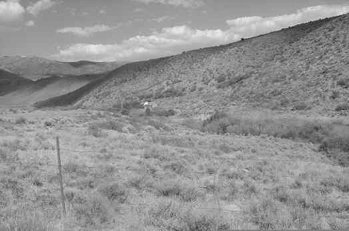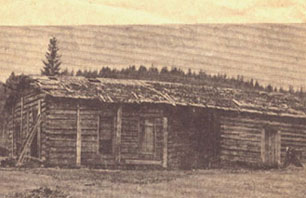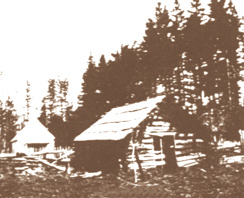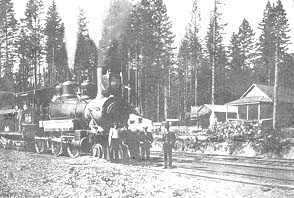Yacolt, Early Years
Compiled by Helen McCutchen Buell, youngest child of George A. McCutchen
Mary's cousin, Charlie Landon, arrrived in the Yacolt area in about 1892 (Stout). Charile homesteaded 160 acres, divided it into 16 lots and offered it for sale as Yacolt townsites. Garner and Farrgar were a couple of others who sold land to early Yacolt settlers. Garner wanted to name the area Garner and for a short time there were two postoffices within a mile of each other, one named Yacolt and the other, Garner. The US Postal Department said one had to go because they were too close and after much explosive discussion, the Garner office closed in 1895. Unlike Charlie, Garner and Farrgar did not homestead their land; they bought it from the Northern Pacific Railroad.
Charlie wrote letters to the McCutchens extolling the virtues this land in the southwest coast of Washington state. He told of tree covered mountains and fertile valleys fed by meandering creeks and rushing rivers. To the McCutchens, who lived on an arid ranch where water was scarce and wind was all too present, Charlie's descriptions must have seemed like Paradise. In the late fall of 1894, the McCutchens arrived in Yacolt, after a nearly 3 year trip from Elko, NV.
|
|
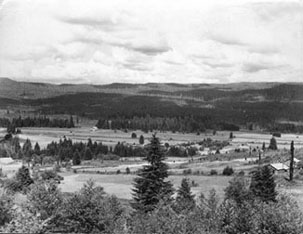 Photo 2: Yacolt in the 1940's. In the 1890's there were even more trees. There were two creeks and a swale (small swamp) on the McCutchen property. The white spot to the left of center is the McCutchen barn. |
The new community of Garner/Yacolt consisted of the Landon cousins, Charlie and Willie, and 5 families. The McCutchens, newly arrived, made 7. There were enough children for a school and one of the families had donated land for a school house which was built by volunteers. Then the granting family sold their property. The land the schoolhouse was on had not been legally granted to the town so the new owner moved into the building leaving the community without a schoolhouse. Another family donated a temporary building. This solved the building problem for that year but they still had not teacher when the McCutchens arrived in town. Mary offered to teach if her family could stay in the building for the winter. So the family moved in and Mary set up school in her living room. Once they moved into their own home, she gave over the teaching to others.
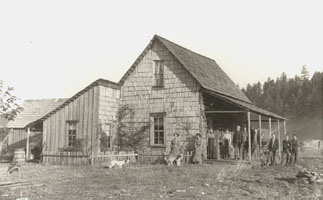 |
Photo 3: The back part of the house was built first. By 1900, the house had more than doubled in size. The lines of the original shed were softened by the new addition with its two floors, gabled roof, shingle siding, and shady porch. This house burned down soon after this photo was taken. Jim, Mary, most of their grown children and some cousins from Elko are in this photo. To see them, Click here |
Jim and the boys built a house as quickly as they could the next spring, more of a shed, actually, but adequate to keep the family warm and dry while they built the more important barn and other outbuildings. That same year, they donated land to build a small school house at the edge of their property towards town. Jim hauled the lumber and furnishings for the school as well, then he was elected to the school board. School records also show that Will and George helped build a fence for the school.
|
Photo 4: The Yacolt post office, built about 1884. The Garner post office was very close, closer then the required mile between US post offices. Photo taken in the 1970's. Building is not now standing. |
Garner was the name of one of the area's pioneer families. In 1886, after much explosive discussion, the Garner post office closed. Yacolt means "haunted" in the local Indian dialect, and comes from the legend that an Indian maid became lost while picking berries and still haunts the area. |
Photo 5: Yacolt's first two schoolhouses. Mary taught in the older one. The newer one was built on donated McCutchen land in 1895. Photo taken in the 1960's. Neither building is not now standing. |
The McCutchens were active in the community, serving on the school board, belonging to the Community Methodist Church, and participating in the Grange and Odd Fellows organizations. Mary never taught after that first winter, but the children all attended school. My father completed the 8th grade, which in farm country in the early 1900's was more than many did. A few years after Jim donated the land for the little one room school, the City of Yacolt built a new one, closer to town.
 Photo 6: This building housed classes from first grade through high-school the first years of its life when this photo was taken in the 30's, housed only grade-school children. I went to school here in the late 40's. |
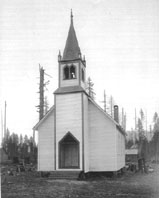 Photo 7: The burned trees in the background confirm that the Methodist Church, shown new here, was built soon after the 1902 fire. |
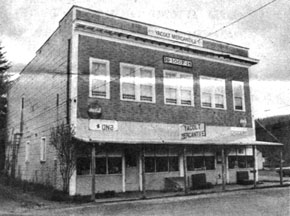 Photo 8: The Odd Fellows hall was one of the social centers of the community, with dances and other get-togethers as well as regular meetings. Built in 1913, it is now the oldest standing building in Yacolt. |
Yacolt of the early 1900's was a boomtown, boasting a hospital, a high-school and a newspaper. Logging was the major industry and the McCutchen boys all did some logging although none stayed with it for long. Even so, it left its mark--Logging accidents crippled Bill so that he limped for the rest of his life, killed Cal while he was still young, and fatally injured Walt, although he lived as an invalid for some time afterwards.
 Photo 9: Yacolt in 1906. Notice the distinctive many windowed school house at the far left, the spired church towards to the left of center and the railroad track in the right-hand corner, and the stumps in front, left from trees burned in the fire of 1902. Larger view |
|
In 1902, one of the biggest forest fires in history. It just missed Yacolt townsite but burned much of the surrounding area, including the newly remodeled McCutchen house. (Notice the burned trees behind the church above.) The Yacolt Burn devastated a strip 10 to 15 miles wide extending from the Wind River on the east to the North Fork of the Lewis River. In its wake, it left at least 20 people dead and more than 100 families, like the McCutchens, lost their homes. They also lost a new barn Jim had been building. The updraft from the fire picked the barn roof up, carried it about 300 feet and sat it down on the ground where it burned it up. Jim immediately started building a new house. See McCutchen Homestead.
Most photos from collections owned by Robert J. McCutchen, Vera White and Helen Buell
Information on Yacolt from the Clark County Historical Museum
